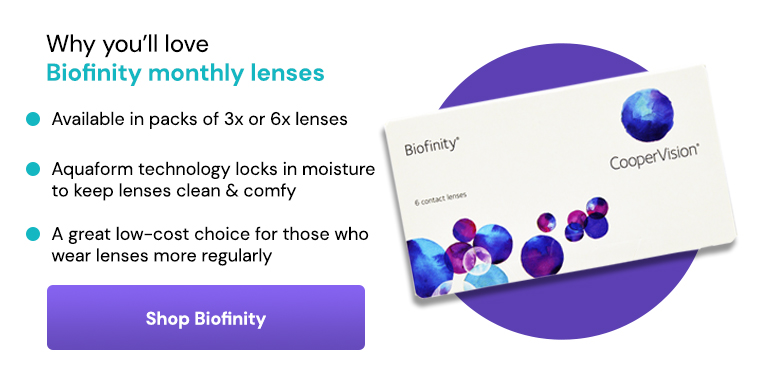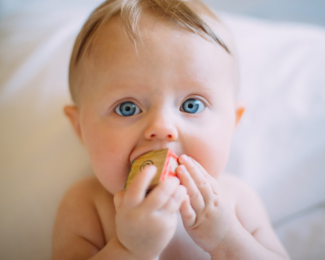The Development of Babies’ Eyesight
It’s natural for new parents to ask various questions about their newborn baby. As the baby grows in the first few months to a year, there are plenty of changes to witness. Vision is something that develops and changes quickly in babies, from eye colour to being able to see clearly.
Lenstore reveals insights about the development of babies' eyesight, how to encourage good vision in babies, and how to spot sight problems.
The development of babies’ eyesight from birth to 12 months
Newborn - 4 months:
When babies are first born, their vision is still blurry, and they can only see objects or features that are 8-10 cm away from them. However, by the time they reach three months, they will begin to develop hand-eye coordination.
5 – 8 months:
This stage is where you’ll see the biggest changes in a baby’s vision; hand-eye coordination will continue to develop, and they will acquire the ability to determine how close or far away an object is from them.
Additionally, a baby’s colour vision will begin to improve during these months. During these months they’ll be able to see the full colour spectrum and differentiate colour tones.
9 – 12 months:
By the time a baby is 12 months, their vision will be fully developed, and they should be able to see clearly, focus and judge distance.
When does babies' eye colour change?
There’s no guarantee that your baby’s eye colour will change, but if it does, it is usually between 3-6 months. After this, you may still see changes in your baby's eye colour, such as going from brown to hazel, or bright blue to a darker blue.
When do babies start to see colour?
Newborns can only see black, white, and grey. As their colour vision begins to develop, the first colour babies see is red. At around two months old, they begin distinguishing different tones, and it is believed that they can see and recognise the full colour spectrum by the time they reach five months old.

What colour eyes will your baby have?
There is no way to 100% predict the colour of a baby's eyes. The colour of babies eyes is down to genetics, and it’s not guaranteed that a baby will have the same colour as their parents. This is because eye colour is determined by variations of multiple genes. Genes are inherited from parents, and there are dominant and recessive genes.
For example, brown eyes are more dominant than blue eyes, so if one parent has brown and one has blue, it’s more likely their baby will have brown eyes. However, there are cases where genes skip generations and babies end up having their grandparent's eye colour or where the recessive gene takes hold because grandparents also have blue eyes.
How to encourage good vision in babies
The best types of food:
A healthy diet is essential for children’s health, including their vision. A balanced diet and drinking enough water are essential, however, there are some specific foods that are known for being good at boosting vision. These include:
- Fish
- Leafy green vegetables
- Eggs
- Almonds
- Citrus fruits
Of course, at a young age, these foods won’t be able to be eaten whole, so making purées from these ingredients will help them to eat these eyesight-boosting foods. Once old enough to eat whole foods, including these in their meals will continue to positively affect their eyesight.
How to clean a baby’s eye at home?
Having discharge in the eye is extremely common in newborns and babies, but ensuring they’re cleaned properly is essential in preventing further problems.
- Firstly, wash your hands with soap and water.
- Wet a clean cotton pad with either water or, if you have it, saline solution.
- Using a new cotton pad for each wipe, gently wipe your baby’s eye from the inside corner to the outside.
- Once the discharge has been removed, take a clean, dry cotton pad and wipe your baby's eye from the inside corner to the outside.
- Wash your hands once complete.
What to look out for in baby eyes?
It’s good to keep an eye on your baby's eyes as they can be easily infected or irritated. If discharge continuously comes back, or the baby’s eyes begin showing other symptoms such as redness, this may be a sign of conjunctivitis, so be sure to tell a doctor.
Other things to look out for include them not being able to open their eyes, if they’re rubbing or touching them, excessive tearing, their eyes constantly wandering, or their eye looking swollen and sore.
When to get babies’ eyes checked?
If your baby has any symptoms including swelling, redness, tearing, crusted eyelids, a white pupil, wandering eyes, or it seems like their eyes are generally irritating them, see a doctor as soon as possible to prevent further problems.
In their younger years, babies will have a number of check-ups on their eyes; they’ll get health and development reviews until they’re two years old. It may also be beneficial to get your child’s eyes checked before they start school, around 4 or 5, to detect any problems early on and prevent them.
Spotting vision problems in babies’ eyesight
Throughout their younger years, babies will have a number of eye tests to ensure their vision is where it should be. However, it is still important to seek medical advice if there are signs of any problems or if there are any worries from parents.
Although their hand-eye coordination won’t be perfect when still a baby, their eyesight should be pretty much developed by the age of 1, and hand-eye coordination should start seeing improvements. However, if it’s not improved over their first year, this could indicate that there is a problem with their vision.
Another sign is that the eyes do not point in the same direction. Again, this is normal in the first few months whilst their vision is developing, but from around 3-4 months old, their eyes should be aligned.
Other signs to look out for, typically in toddlers and older child include:
- Holding objects, such as a book, very closely
- Sitting close to the TV
- Straining their eyes to enable them to focus
- Suffering from regular headaches
- Rubbing their eyes a lot
Treating eye infections in babies
As you would with any infection, seeking medical advice is vital. Most eye infections are extremely contagious, so the sooner they’re treated, the better. Conjunctivitis, also known as pink eye, is very common in infants, and if it’s the type that’s caused by bacteria, antibiotic eye drops will be prescribed. However, if it’s caused by a virus, your doctor will suggest alternatives.
Healthy eyes and vision play a crucial part in how babies and toddlers learn to see, so ensuring they're developing how they should be and knowing the signs of infection or vision problems is essential.
Cataracts in babies
Cataracts in babies and children are rare. In the UK, around 2 to 3 in every 10,000 babies are born with cataracts.
Cataracts occur with a change in the lens. The lens is a transparent structure located behind the pupil that allows light to pass through the light-sensitive layers of tissue at the back of the eye. Cataracts can cause the lens of the eye to become less transparent, which can result in a cloudy or misty vision.
Spotting signs of cataracts in babies and young children can be difficult, but newborns have their eyes examined within 72 hours of birth and again when they’re between 6 – 8 weeks old to help spot the signs.
Often, cataracts have little to no effect on a babies vision. However, if it does slow down or stop their normal sight development, surgery will be recommended as soon as possible to remove the affected lens or lenses.
After surgery, it is common for children or babies to wear contact lenses or glasses to compensate for the removed lens. Sometimes an artificial lens may be used in surgery to replace the affected lens.
Parents or guardians must insert, remove and handle the contacts lenses on behalf of their baby or child until they able old enough to do it by themselves to ensure that the contact lens is worn safely.
Predicting how much improvement will be seen in your child’s vision after treatment is difficult, but it’s likely there will always be a degree of reduced vision in the affected eyes.



